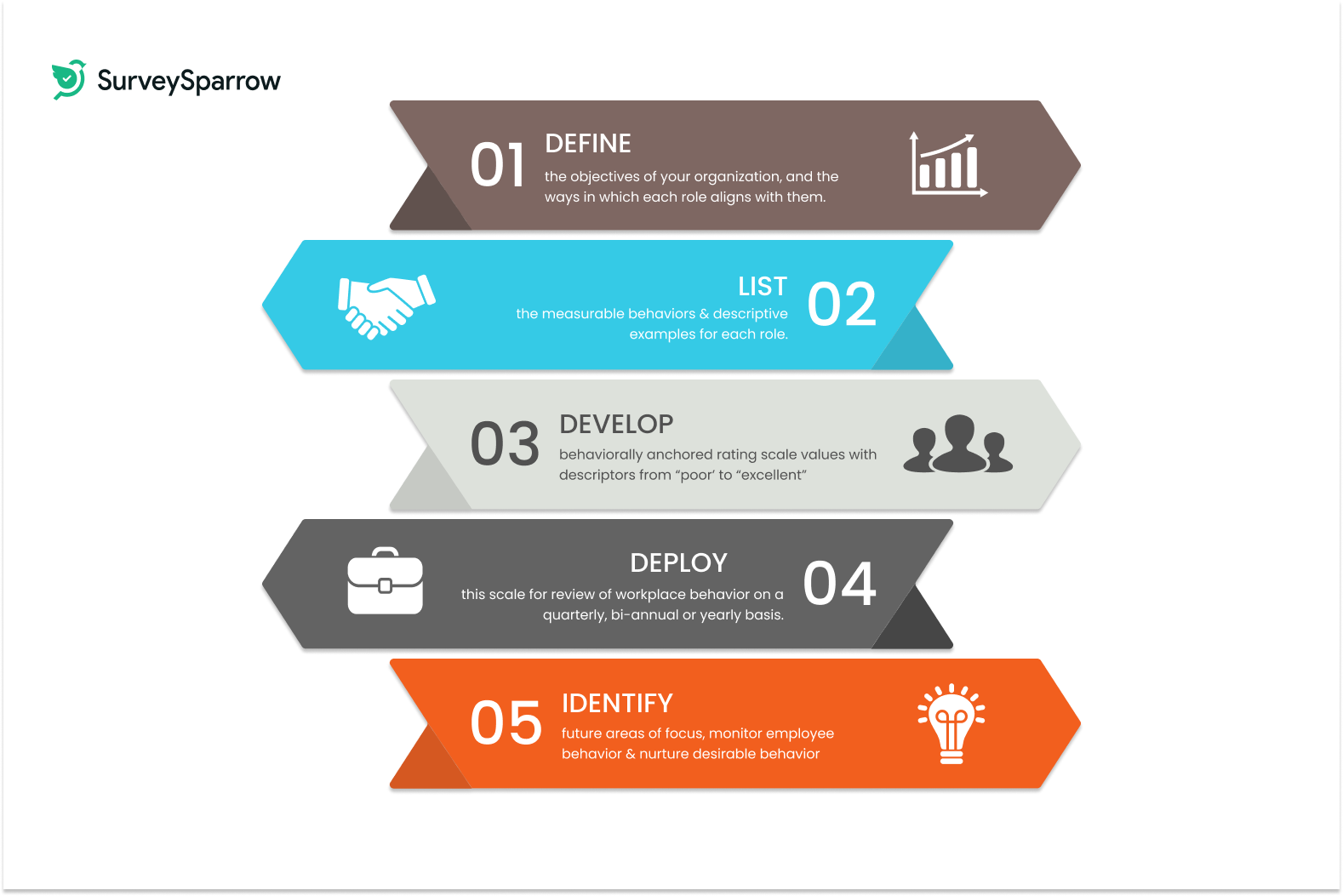Employee Experience
Behaviorally Anchored Rating Scale: All You Need to Know
Article written by Parvathi Vijayamohan
Content marketer at SurveySparrow.
7 min read
9 October 2024

If you manage a team of employees, it’s important to have a way to fairly and accurately assess their performance. One popular method to do this is the behaviorally anchored rating scale (BARS).
In this blog post, we’ll give you everything you need to know about behaviorally anchored rating scales:
- What are behaviorally anchored rating scales?
- How to use BARS in performance evaluations
- Why you should (and shouldn't) use BARS
- How do you implement BARS in your organization?
What is a behaviorally anchored rating scale (BARS)?
A behaviorally anchored rating scale (BARS) is a quantitative method of evaluating employee performance that uses descriptive ratings. That sounds like an oxymoron, but it isn’t.
In other words, BARS are like vertical scales, similar to ruler markings. But instead of centimeters or inches, it has ratings, with descriptions and examples assigned to each rating.
The key focus of BARS is behavior; behavior ratings are collected according to specific work criteria. These ratings can be on a five, seven, or nine-point scale.
However, each number represents a level ranging from poor to moderate to good. Also, each level comes with behavioral examples.

How to use BARS in performance evaluations: A step-by-step breakdown
- A behaviorally anchored rating scale is a tool to rank specific employee behaviors. Unlike, say, a generic rank for a skill.
- For this reason, managers need to choose behavior that is specific to each role.
- How do you choose those behaviours? First, use job analysis methods like the critical incident technique (CIT) to identify the essential job duties and requirements for a role.
- Then, use this information to outline the key performance areas and the expected standard of behavior for each area.
- Assign BARS values to each area. Your final scale is ready for distribution.
- In order to evaluate how well an individual has performed, we compare and analyze the ratings alongside the standard.
- These ratings are then used as performance benchmarks by the management. These benchmarks help them measure an employee’s proficiency in the areas that matter to them – such as dependability and job knowledge.
- By assessing this data, a company can provide feedback that’s more concise than “You need to work on XYZ.”
Now, BARS is great for rating specific behaviors. But if you want to take it up a notch, you need to try SurveySparrow’s 360° feedback tool. It gathers feedback from all around—coworkers, managers, and even subordinates—to give you a more detailed picture of how someone is doing.
Plus, with our customizable survey templates, you can ask the right questions for any role. This makes it easier to understand an employee’s overall performance, not just specific behaviors.
Click below to get started.
Employee 360 Review Template
Use This TemplateWhy you should (and shouldn't) use BARS in performance management
+ Pros:
- A behaviorally anchored rating scale can be an effective tool because it provides both descriptive and numerical data.
- Through the use of predetermined criteria – such as skill levels, finished tasks completed or quality of work – the BARS provides an objective assessment of employee achievement over time.
- By combining traditional ranking scales with behavioral observations, companies are able to provide meaningful feedback that strategically improves their staff’s performance.
- By using BARS, employers can assess and rank major job responsibilities in terms of their importance.
- Using this method, managers can gauge whether employee behavior meshes well with the company’s goals.
- Moreover, BARS focuses on behavior instead of outcomes. That’s helpful for creating a working environment that values learning and improvement over strictly measuring results.
− Cons:
- Creating a behaviorally anchored rating scale can be time-consuming. Especially if you have a rapidly growing company or fairly specialized roles across teams.
- BARS as an evaluation tool requires intense effort from managers as well as an in-depth understanding of their employees.
- Assigning weights or determining behavior metrics can be complicated by bias or subjectivity.
- Developing a behaviorally anchored rating scale often requires the help of experts, especially when applying job analysis techniques.
- Fast-changing sectors like SaaS, media and home automation require constant upskills and re-skilling. A behaviorally anchored rating scale may not be the ideal performance appraisal tool in such cases.
Nevertheless, behaviorally anchored rating scales are one of the most effective forms of performance management available today.
A better alternative to the BARS method
ThriveSparrow stands out as a streamlined and user-friendly alternative to the BARS method. Here’s why:
1. Ease of use: Setting up and deploying surveys is straightforward with ThriveSparrow, eliminating the complexity often associated with the BARS method.
2. Flexible customization: Whatever the role or department, you can adapt it to fit your needs. This flexibility ensures that your performance evaluations are always relevant and impactful, offering a level of personalization BARS can’t match.
3. Scales with you: As your organization grows, ThriveSparrow effortlessly scales to meet your expanding needs. This capability allows for efficient feedback collection across any size of team.
4. Track performance trends: Tired of the same tired old spreadsheets? ThriveSparrow’s performance trend chart paints a clear picture of the performance trajectory of your employees across teams.
5. Comprehensive feedback: ThriveSparrow supports 360-degree feedback, incorporating views from peers, managers, and self-assessments. This comprehensive perspective enriches the evaluation process, offering a more complete picture of performance than a typical BARS.
6. Seamless integration: Integrating smoothly with your existing HR tools, ThriveSparrow streamlines workflows and is easy to onboard. Automated reminders and processes ensure that nothing falls through the cracks.
Curious about ThriveSparrow? Sign up here for free.

How do you implement BARS in your organization’s performance management system?
- Include key staff in developing and establishing a comprehensive rating scale, as well as any supporting documentation and criteria.
- Train all organization members using BARS to ensure that they administer ratings effectively and consistently.
- Provide continuous training to managers and supervisors on the use of BARS. This will help maintain a high level of accuracy in performance evaluations.
Wrapping Up
A behaviorally anchored rating scale is a tool that managers can use to rate an employee’s job performance. BARS links specific behaviors to levels of performance. This helps appraisers be more objective in their evaluations.
Although BARS has several advantages, there are also some disadvantages to using this performance appraisal method. If you decide that a BARS is right for your organization, you must create specific behaviors that align with your company’s values and goals.
Once you have created your custom BARS, you can implement it into your organization’s performance management system.
Where does SurveySparrow come into this? You can use our survey templates to create your own customized, branded BARS and fancy dashboards to visualize the results and spot patterns. Book a demo with us today to see how our software can help improve your performance management process.
Start 14 Days free trial

Parvathi Vijayamohan
Parvathi is a sociologist turned marketer. After 6 years as a copywriter, she pivoted to B2B, diving into growth marketing for SaaS. Now she uses content and conversion optimization to fuel growth - focusing on CX, reputation management and feedback methodology for businesses.
Frequently Asked Questions (FAQs)
The behaviorally anchored rating scale was developed by Norman Campbell and Fred Spencer in the late 1960s. They recognized the limits of traditional rating scales, and tried to create a more objective and reliable performance appraisal method.
The critical incident method collects and analyzes specific examples of job behavior that are considered ideal or not ideal. BARS takes the critical incidents one step further by using them to create a detailed rating scale—with behavioral examples for each rating.
This provides raters with clear examples of what makes an excellent, good, average, poor, or a simply unacceptable performance.
Related Articles

Customer Experience
35 Funny Customer Service Memes That Support Teams Will Love
15 MINUTES
27 September 2022

Work Culture
How to Set up a Home Office: A Guide to Work from Home Effectively
11 MINUTES
15 July 2020

Knowledge
Intake Forms: Types, Templates and How to Create It
14 MINUTES
16 January 2024

Customer Experience
Thank You For Your Feedback: 20 Gracious Responses for Customers and Colleagues
10 MINUTES
8 May 2024
